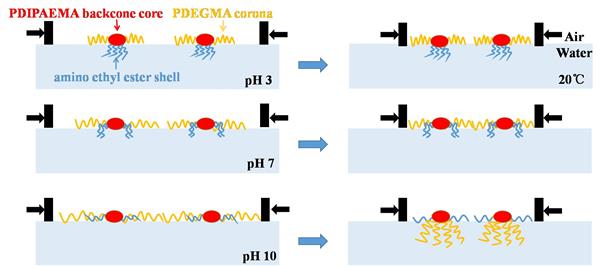- 31.【J. Appl. Polym. Sci.】Effects of subphase pH and temperature on the interfacial behavior of double hydrophilic diblock copolymer PDEGMA-b-PDIPAEMA
- 来源:文纲要教授个人网站 2023-10-23
The aggregation behavior of two pH- and temperature-responsive diblock copolymers of poly[di-(ethylene glycol) methyl ether methacrylate]-block-poly[2-(diisopropylamino) ethyl methacrylate] (PDEGMA-b-PDIPAEMA) at the air/water interface and the structures of their Langmuir-Blodgett (LB) films were studied by the Langmuir monolayer technique and atomic force microscopy, respectively. At the air/water interface, PDEGMA-b-PDIPAEMA tends to form the core-shell-corona micellar structure composed of a PDIPAEMA main chain core, an amino ethyl ester shell, and a PDEGMA corona. Under acidic, neutral, and alkaline conditions, PDIPAEMA blocks are completely protonated, partially protonated, and completely non-protonated, respectively, and the protonated amino ethyl ester groups are immersed in water before monolayer compression, whereas PDEGMA coronas are adsorbed at the interface. At pH 3, 7, and 10, the limiting areas (A0) for PDEGMA42%-PDIPAEMA58% (weight percents) and PDEGMA55%-PDIPAEMA45% are 8.2/10.2/14.0 and 6.7/8.3/8.4 nm2, respectively. The A0 values of the former copolymer are larger than those of the latter. This is because the shells in the former copolymer are denser due to the higher polymerization degree of PDIPAEMA blocks, providing greater steric hindrance for PDEGMA coronas and making the latter more extended at the interface. In contrast to other copolymer systems, the effect of temperature on the isotherms of PDEGMA-b-PDIPAEMA is less obvious.

Article link: http://doi.org/10.1002/app.54898.
Read-only version: https://onlinelibrary.wiley.com/share/author/QKSVRWRPAN6DYVHXEQIJ?target=10.1002/app.54898
- [来源:中国聚合物网]
- 了解更多请进入: 文纲要教授个人网站
- · 35.【J. Phys. Chem. B】Ultrafine Network-like Monolayer Structures of Amphiphilic Hyperbranched Copolymers Revealed by the Relative Aggregation Number Method
- · 34.【Langmuir】Closely Packed Core-Shell Micelle Structures of Double Hydrophilic Mikto-Arm Star Copolymers at the Air/Water Interface
- · 33.【J. Appl. Polym. Sci.】Ionic strength and anion-specificity effects on the interfacial behavior of double hydrophilic block copolymer PNIPAM-b-POEGA
- · 32.【Macromol. Rapid Commun.】Dense Monolayer Network Structures of Double Hydrophilic Hyperbranched Copolymers at the Air/Water Interface